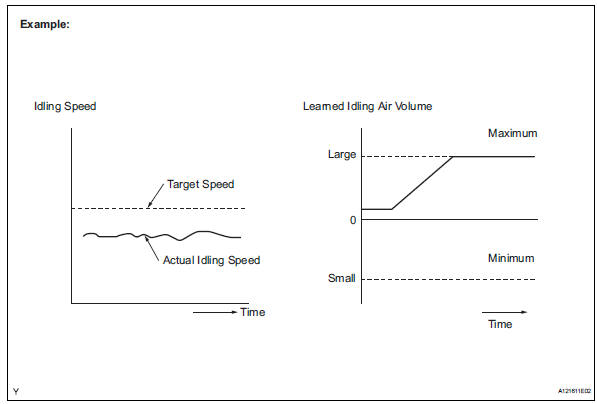Toyota RAV4 (XA40) 2013-2018 Service Manual: Idle control system malfunction
![]()
Description
The idling speed is controlled by the etcs (electronic throttle control system). The etcs is comprised of: 1) the one valve type throttle body; 2) the throttle actuator, which operates the throttle valve; 3) the throttle position (tp) sensor, which detects the opening angle of the throttle valve; 4) the accelerator pedal position (app) sensor, which detects the accelerator pedal position; and 5) the ecm, which controls the etcs. Based on the target idling speed, the ecm controls the throttle actuator to provide the proper throttle valve opening angle.

Monitor description
The ecm monitors the idling speed and idling air flow volume to conduct idle speed control (isc). The ecm determines that the isc system is malfunctioning if the following conditions apply:
- The learned idling air flow volume remains at the maximum or minimum volume 5 times or more during a drive cycle.
- After driving at 10 km/h (6.25 Mph) or more, the actual engine idling speed varies from the target idling speed by between 100 rpm and 200 rpm, 5 times or more during a drive cycle.
Example: if the actual idling speed varies from the target idling speed by more than 200 rpm* 5 times during a drive cycle, the ecm illuminates the mil and sets the dtc.
Hint:
*: Threshold idling speed varies with engine load.

Monitor strategy

Typical enabling conditions
![]()
Typical malfunction thresholds

![]()
Inspection procedure
Hint:
- The following conditions may also cause dtc p0505 to be set:
- The floor carpet overlapping slightly onto the accelerator pedal, causing the accelerator pedal to be slightly depressed and therefore the throttle valve position to be slightly open.
- The accelerator pedal being not fully released.
- Read freeze frame data using the intelligent tester. Freeze frame data records the engine condition when malfunctions are detected. When troubleshooting, freeze frame data can help determine if the vehicle was moving or stationary, if the engine was warmed up or not, if the air-fuel ratio was lean or rich, and other data from the time the malfunction occurred.
- Check any other dtcs output (in addition to dtc p0505)
- Connect the intelligent tester to the dlc3.
- Turn the ignition switch on.
- Turn the tester on.
- Select the following the menu items: diagnosis / enhanced obd ii / dtc info / current codes.
- Read dtcs.

Hint:
If any dtcs other than p0505 are output, troubleshoot those dtcs first.


- Check pcv hose connections
Ok: pcv hose is connected correctly and is not damaged.


- Check air induction system
- Check the air induction system for vacuum leakage.
Ok:
no leakage from air induction system.


- Check throttle valve
- Check the throttle valve condition.
Ok: throttle valve is not contamainated with foreign objects and moves smoothly.


 Brake switch "A" / "B" correlation
Brake switch "A" / "B" correlation
Description
The stop light switch is a duplex system that transmits two signals: stp and
st1-. These two signals are
used by the ecm to monitor whether or not the brake system is working prope ...
 Cold start
Cold start
Description
The electronic throttle control system (etcs) controls the engine idling
speed. The etcs operates the
throttle actuator to open and close the throttle valve, and adjusts the intake ...
Other materials:
Operating an ipod
Connecting an ipod enables you to enjoy music from the vehicle
speakers.
Connecting an ipod
Open the cover and connect
an ipod using an ipod cable.
Turn on the power of the ipod if
it is not turned on.
Press the “media” button repeatedly until “ipod” is displayed.
...
Shift lock system
Parts location
System diagram
On-vehicle inspection
Check shift lock operation
Move the shift lever to p.
Turn the ignition switch off.
Check that the shift lever cannot be moved to any
position other than p.
Turn the ignition switch on, depress the brake
pedal and chec ...
Mechanical system tests
Stall speed test
Hint:
This test is to check the overall performance of the
engine and transaxle.
Notice:
Do not perform the stall speed test longer than 5
seconds.
To ensure safety, perform this test in an open and
level area that provides good traction.
The stall speed test sh ...
